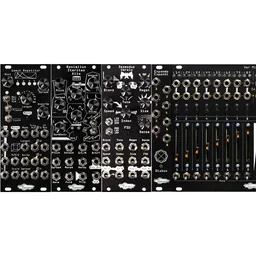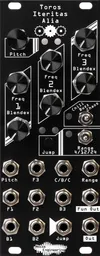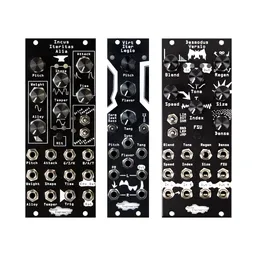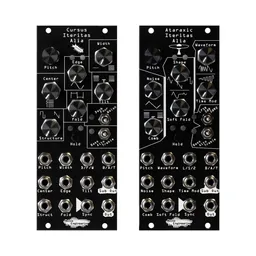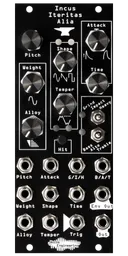Last week, we released three new firmwares for the Alia: Ataraxic Iteritas, Cursus Iteritas, and the new Incus Iteritas. We’ll chat about the return of Ataraxic and Cursus next week, but today, we’ll take a deep dive into Incus, its history, and all the things it can do.

Incus: a little bit of everything
From the start, we wanted Incus to have as big a timbral range as possible, and for each control to do something interesting on its own. Over the years we’ve learned quite a few synthesis tricks, and Incus combines a lot of our favorites. The result is a voice that has a little bit of additive synthesis, some wavemorphing, two types of distortion, and FM – and despite that complexity, it’s quite easy to control.
We started Incus with percussion in mind, but by borrowing Debel’s attack/decay envelope we extended the module’s time ranges drastically, breaking it out of the purely percussive space. The internal envelope modulates FM amount, pitch, or noise, too, so even without external CV it’s quite an expressive voice. I’ve been using two in my system recently: one for a variety of massive techno kick sounds, and the other for FM stabs. Just listen to the patch examples in this manual video – it’s got it all.
Explore all the synthesis
As you can see, Incus covers a lot of ground when it comes to different synthesis techniques. I’m a huge fan of starting with simple waveforms and using distortion to make them more harmonically interesting, and Incus offers a couple of ways to do that. The Temper parameter controls a complex wavefolder, which is a wonderful sound design tool and an excellent CV target. When Alloy is turned down, Weight adds saturation to the signal, too, for a different flavor of distortion. Add some FM or a pitch envelope to both of these parameters and you’ve got some massive sounds with just a couple of tweaks.
When Alloy is turned up, you can explore additive synthesis, too: Weight controls the tuning of the additive oscillators, and in Heavy mode, also changes the tuning of the FM operators. Alloy and Weight are two of the most impactful parameters on the resulting sound.
Speaking of FM, Attack behaves like a normal envelope attack parameter to the right of noon. Below noon, though, it controls a different synthesis parameter depending on the synthesis algorithm. In Grind mode, turning Attack down increases the decay time of a tuned noise oscillator. In Impact mode, attack routes a decay envelope to the pitch of all oscillators, perfect for big kicks and impacts. In Heavy mode, FM is added as attack is decreased, creating complex timbres.
All of these options open up a lot of possibilities. Need a supersaw? Turn Shape up, use Weight and Alloy to create some detuned copies of the base waveform, and adjust the envelope Time to taste. Need a kick? Turn Shape to the sine position, switch to Impact mode, and adjust Attack to dial in the transient. Need a snare? Just flip to Grind to add some noise.
The backstory
Incus was born shortly after the release of Debel. We wanted to explore some of the synthesis concepts from the original BIA, but with a different style of envelope. Originally, the parameters were nearly identical to the BIA, but built on the engine developed for Debel, resulting in an entirely different sound. As we tested the new firmware, we changed things more and more: the biggest deviation was adding FM, and the expanded concept of the modal bipolar attack parameter was born. That opened up a lot of possibilities, and we were able to narrow down the three synthesis algorithms we wanted to use.
What struck us most was that even though the core concepts between BIA and Incus were quite similar, they created very different timbres and complemented each other very nicely. As testing continued, we focused on dialing in the individual parameters for jamability and expanding the sound design possibilities. One of the last additions was the saturation on the Weight parameter. It was a small change on paper, but it made a massive difference in the range of sounds the module could produce.
Incus came together quite quickly, and despite a few hiccups along the way it was a joy to develop.
Swap it on to your Alia
Incus is available now as a paneled module from our webshop and from retailers – if you need an anvil in your system, this is the module for you! However, if you already have an Alia, you can try out the Incus firmware (as well as the returning Ataraxic Iteritas and Cursus Iteritas firmwares) completely free at the Customer Portal.
